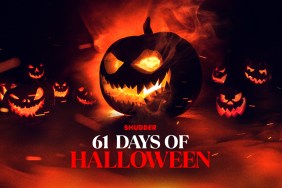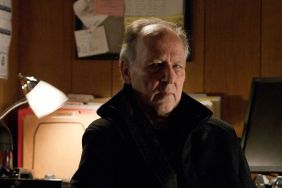
SHOCK editor bites deep into German filmmaker Werner Herzog’s haunting 1979 film NOSFERATU: PHANTOM DER NACHT.
Immortality. We all want it. The chance to defy that black specter of death that equalizes us. But to live forever, drifting through time like a ghost; residue of a memory, unattached to anything, anyplace anyone. Hiding in shadows until the earth stops spinning. The crushing loneliness of it would it really be worth it?
Thats the central driving thematic force behind director Werner Herzogs dark, dreamy, full color remake of the immortal 1922 German expressionist classic NOSFERATU. A film that, although deeply indebted (sometimes almost scene for scene) to the iconic, silent original, still manages to evolve beyond its experimental horror roots, taking its essence from F.W. Murnau (like a vampire would, in fact), assimilating that blueprint and then injecting liberal amounts of lyricism and a driving force of deep, bittersweet melancholy. The resulting work is among the inimitable Herzogs most powerful and important films.
After a string of incredibly successful art house favorites throughout the late 1960s and early 1970s, Herzog, who alongside trailblazing filmmakers Rainer Werner Fassbinder and Wim Wenders, was a major figure in the German new wave movement, turned his gaze to the film he correctly acknowledged as the single most important German movie of all time. Indeed, the director had set his sights on remaking Murnaus shuddery unauthorized Dracula adaptation, shooting both German and English language versions and applying his own unique cinematic aesthetic to the oft filmed tale of the bloodsucking undead.
Unfortunately, at the same time Universal was also prepping the John Badham / Frank Langella take on the Hamilton Deane stage version of DRACULA and MGM were launching the post-disco era George Hamilton spoof LOVE AT FIRST BITE, both easily accessible to mass-audience sensibilities and hugely popular. Herzogs languid, meditative anti-horror film was completely at odds with both the times and stateside sensibilities and his film, NOSFERATU: PHANTOM DER NACHT (or NOSFERATU: THE VAMPYRE as it was known in the US and UK), although critically praised by many, got lost in the sanguinary shuffle, deemed by some as pretentious and thought by some critics to be a pointless attempt to revisit a picture that was already perfect as is.
Of course, that simply is not the case and time has, like it often does with most enduring masterworks of dark cinema, proved any naysayers wrong. Herzogs epic tale of disease, death, love, loss and isolation is absolutely one of the most evocative and emotional vampire film ever committed to celluloid.

To fully appreciate the one of a kind wonder of NOSFERATU: PHANTOM DER NACHT, one must first understand the work of its creator. Born and raised in a remote German mountain village, one completely untouched by technology, young Werner would grow up in an environment two shades shy of the Stone Age, not making his first phone call until he was 14 and not seeing his first film until he was 17. But Herzog had something far better than modern distractions to inspire him. He was surrounded by the beauty of the natural world; of mountainous terrain, unforgiving nights and swooning days; of green grass, gentle winds and free flowing rivers. Herzog would grow up understanding nature, respecting it and most importantly, he was deeply humbled by it. He understood infinitely that mother earth was an unforgiving mistress; a bitch goddess that could kiss as easily as kill and only a fool would dare attempt to gain the upper hand against her.
So when life propelled him towards becoming what he would become, Herzog began making movies that told tales of dangerous eccentrics, heroes and madmen whose sometimes valiant, often vain, efforts to conquer nature result in their ruin. Thing is, Herzog would often choose to film these pictures in the very bowels of the badlands and wild worlds that his scripts painted as treacherous, using locals and natives as extras and often personally teetering on the very destruction he sought to chart.

His front-of-lens collaborator for 5 astounding films, the probably legitimately insane performance artist Klaus Kinski, he of the blond hair, widely spaced eyes and twitchy lips, would in essence become the extension of Herzog; his dark side, the embodiment of his vice and his irrational desire to perhaps subconsciously cause his own destruction. The two became close friends but also, famously, mortal on-set enemies, once even plotting to murder each other behind the other’s back (check out the stirring Herzog documentaries BURDEN OF DREAMS and MY BEST FIEND if you dont believe me). The fact that Herzog would eventually cast his beloved nemesis as the Lord of the parasites, speaks volumes about their unique and creatively volatile relationship.
Now, as every horror historian knows (but well recap here for those who dont), back when Murnau decided to adapt Stoker for the screen, he ran into a huge problem: Stokers widow was very much alive and in possession of both her faculties and the rights to her hubbys estate. And she wanted cash. A lot more cash than Murnau was planning to part with. So Murnau, ever the arrogant brat, got the idea to tweak names and places in the story, changing Stokers suave Transylvanian Count into a bald, bone- white, taloned freak named Orlock, and went ahead as planned, calling his picture NOSFERATU instead. As only a moron would miss the narrative disguise, the widow Stoker sued the director within an inch of his life, resulting in the courts ordering all prints of the picture to be destroyed. But they werent and years later some of them surfaced, the film was hailed a lost classic and the rest is horror lore.
When it came time for Herzog to make his own tribute to this remarkable picture, the Dracula property had lapsed into the public domain, meaning he could call his villain Dracula and change the names and places back to their rightful literary origin. His plot, however, follows the original films setup verbatim: Jonathan Harker (here played by notable German actor Bruno Ganz, perhaps best known now as Hitler in the film DOWNFALL) lives in quiet bliss in Virna with his porcelain skinned wife Lucy (played by the ravishing French actress Isabelle Adjani). One day, Harkers giggling, half-mad boss Renfield (brilliantly played by author Roland Topor, the same Roland Topor who wrote the novel on which Polanskis THE TENANT was based) sends him on an expedition to Transylvania to sell property to one Count Dracula (Kinski), a long trip he promises will cost the young go-getter plenty of sweat and blood.

Harker leaves his beloved Lucy and begins his serpentine journey to Castle Dracula where, after enduring weeks of endless horror, he discovers his host is in fact a night-crawling, neck-nipping monster. As Dracula packs up his black coffins and heads to Harkers hometown, specifically to sample the wares of his wife, a fever-ridden Harker must escape his tower prison and beat the rat-bringing, plague- carrying vampire to the punch before its too late.
Theres nothing in that synopsis that you havent read or seen before, but remember, this is Dracula retold by a man who tells tales a bit differently than most. This is Werner Herzogs Dracula, shot on staggeringly eye filling locations in the Netherlands, filled with impossible beauty, eccentric characters and most importantly an almost overwhelming sadness. The film is, as are all Herzog pictures, free of artifice and special effect save for Kinskis shocking make up design, cribbed wholesale from the original fiend played by actor Max Shreck. Indeed the first time we see Kinski, his bald, pointy-eared, rat-toothed visage is shocking; hes a creature completely at odds with the natural beauty around him. This Dracula, for all his hideous, otherworldly, appearance, is simply another one of the directors dangerous outsiders, a thing who has been blessed and cursed with the secret of eternal life and yet forced to live as an outcast, skulking in rotting tombs, in a twilight shadow world, free of any sort of comfort or love.
And this vampire needs love, or rather needs to be loved.
And what of Kinski? Does this lunatic who so viscerally brought the monkey-tossing, delusional Don Lope de Aguirre and the megalomaniacal FITZCARRALDO to screeching life, manage to successfully essay a miserable, attention-starved vampire fiend whos bloodlust is only matched by his despair? Fucking right, he does. Whether glowing in the moonlight, hungrily eyeing a dining Harker or creeping up on the beautiful Lucy, Kinski manages to create a monster that is as pathetic as he is terrifying, who wants to re-join the human race but whose disdain for it keeps him terminally distanced from everything.

Witness the climactic scene where a broken-hearted Lucy finally invites Dracula to drain her, hoping to drown him in daylight and save her husbands soul. In the original, Max Shrecks Count Orlock simply drinks her dry but here, with Kinski in the role, he vainly attempts to engage in normal lovemaking, clumsily pulling up Lucys dress, clutching her bosom, sniffing her like a suspicious dog, before she lets him off the hook and just pulls him to her throat. Its an erotic (though free of nudity or traditional erotica tropes), tragic and macabre sequence and there has never been anything like it onscreen before or since.
Theres one paralyzing section in Herzogs NOSFERATU that long ago made it one of my favorite films. As the rat plague brought by Dracula ravishes Virna, killing men, women and children without mercy, Lucy wanders the streets trying to convince the few survivors of the undead menace in their midst. The haunting sounds of Herzogs regular composer, the late Florian Fricke (aka progressive rock outfit Popol Vuh) bleeds into an otherworldly Georgian Choir, their mournful sound drifting across a tableaux of an inevitable death. Pigs shit in the street, men try to mate with sheep, children dance with fiddlers, couples make love on the cobblestones and Lucy, dressed in white, raven hair pulled tight in a bun, almond eyes open wide weaves within it all. A table in the middle of the madness sees handsomely attired men and women dining and drinking, inviting Lucy to sit with them. We all have the plague a woman says matter-of-factly as rats dart in and out from between her legs, and we want to enjoy every last minute we have left.
A frame later and the people are gone. Their feast now simply a table full of hordes of diseased rats. Chilling and beautiful stuff…. watch it below
NOSFERATU: PHANTOM DER NACHT might just be Werner Herzogs ultimate masterpiece. A moving, haunting portrait of the mercilessness and inevitability of death but also a stark statement about how sometimes a brief life filled with warmth, love, beauty and belonging is better than an endless one filled with nothing but want. From the gorgeous cinematography, heart breaking performances, eerie, unforgettable music and even the quintessentially Herzogian dark humor, this is one of the few motion pictures that benefits from several serious viewings, preferably alone, without a break of any kind. To say it pales beside the original is to miss the point .









